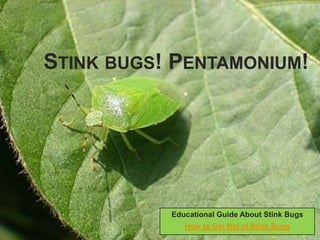
Stink bugs! pentamonium!
- 1. Stink bugs! Pentamonium! Educational Guide About Stink Bugs How to Get Rid of Stink Bugs
- 2. Pentatomoidea Pentatomoidea. No. That isn't the name of a beautiful Greek goddess or a coastal city that sits on a Mediterranean beach. Pentatomoideais a very pretty name for a very stinky bug. Pentatomoidea is the scientific nomenclature for the infamous stink bugs. They smell something heinous. It isn't poisonous to humans, but when and if you smell it you'll think it might as well be.
- 3. Pentatomoidea The stink bug is also known as a shield bug because of its shield-like exoskeleton. They are known as stink bugs because of a flagrant scent they expel when they are threatened. Stink bugs are native to China, Japan and Korea.
- 4. Pentatomoidea There are variations between different species of stink bugs that can be easily identified through variations in body colorings, though all stink bugs have sucking mouthparts and broad bodies. On account of this distinction they are further divided into fifteen different species. Among them, brown and green stink bugs are the most famous types.
- 5. Brown Stink Bugs Brown stink bugs, otherwise known as the brown marmorated stink bug or Halyomorpha, are among the most common type of stink bug found in the U.S. The size of fully matured brown stink bugs range from 1.5 to 2 centimeters.
- 6. Brown Stink Bugs When they are nymphs, or babies, they have a red pigment which turns black as they age and eventually brown. This brown color is found on their shield-like exoskeleton, on their backs, and their underside remains white throughout their growth process. The white stripe on their brown legs is what differentiates brown stink bugs from similar looking insects.
- 7. Brown Stink Bugs Halyomorpha are considered to be pests in agricultural settings, such are farms and gardens. They cause damage to fruit and vegetable crops alike. You may find these stinky insects near or around the following items as they are known to be attracted to the following shrubs, fruits, and plants: apple, birch, butterfly bush, catalpa, citrus, cucumber, dogwood, grape, hackberry, maple, pear, pepper, plum, redbud, tomato, serviceberry, and sunflower.
- 8. Brown Stink Bugs The most common and sometimes not answered question, for people who have a stink bug issue, is how exactly stink bugs harm can harm their various crops and plants. Brown stink bugs use their proboscis, or straw-like mouth, to suck the host plant, create necrotic areas, or spots of dead cells, on the surface of fruits.
- 9. Brown Stink Bugs They can also cause loss of seeds and transfer diseases to the plant itself. Similar to other insects, brown stink bugs hibernate during the winter, which is why they can still be a hazard in the winter; they are looking for a home where the temperature doesn’t fall so drastically, such as window and door frames. Spring time is when they cause the most damage to your harvest.
- 10. Green Stink Bugs Also known as Acrosternumhilare or Asian stink bug, the green variety of these critters is very similar to the brown version. Green and Brown stink bugs affect mostly the southern parts of the U.S. One difference is obviously the color variation. Adult green stink bugs have an orange stripe that divides their heads from bodies.
- 11. Green Stink Bugs Green stink bugs can be usually be found near or at soybeans, and orange, cherry and apple trees. Green stink bugs blend in well with their surroundings on account of their color, and that is why many times damage caused by green stink bugs usually goes undetected. Additionally, they lay eggs on their host plants in large numbers.
- 12. How To Get Rid of Stink Bugs Unleashing parasitic wasps in a stink bug nest will eliminate stink bugs naturally. Seal entry points inside and outside the home helps keep stink bugs out. Use a high-powered vacuum cleaner to swipe up any current nests of stink bugs around the home. Install light traps that attract stink bugs and capture them for easy disposal Pest professionals guarantee the removal of stink bugs around your home.
- 13. Conclusion In conclusion, if you are out in your garden or farm and you see a critter similar to the description above; do not squish the bug because it will spray a sticky and stinky substance on you. Use the information and tactics above to make an educated decision on how to get rid of stink bugs.
Editor's Notes
- How to get rid of stink bugs - http://www.pestexterminator.com/stink-bugs-states/
- How to get rid of stink bugs - http://www.pestexterminator.com/stink-bugs-states/